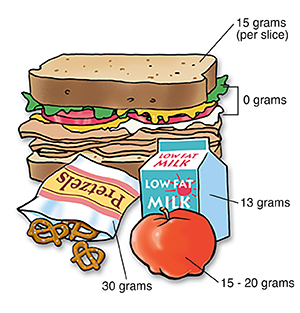For Kids: Food Facts When You Have Type 1 Diabetes
You may think that people with type 1 diabetes can’t eat their favorite foods, but that’s not true. You can still eat most of the same foods your friends eat. You just have to balance what you eat with insulin. That may seem like too much to think about right now. But don’t worry. Your health care team will help you and your family plan meals and snacks that will help keep your blood sugar in your target range. You’ll feel best when your blood sugar is in range.
 |
| Watching how many carbohydrates you have helps you manage blood sugar. |
What’s for lunch?
The energy in food comes from carbohydrates, protein, and fat. Carbohydrates (carbs) raise blood sugar faster than other foods. This is why you must keep track of the number of carbs that you eat. Carbs are found in fruit and in starchy foods such as potatoes, corn, and beans. They are also found in dairy foods such as milk. Let’s look at the different parts of a lunch to see how each one affects your body:
-
Bread is a starchy food, so it will raise your blood sugar. Bread also gives you energy. It’s okay to have some bread. Just don’t eat too much.
-
Lettuce, tomato, and other vegetables have some carbs, but not a lot. They won’t raise your blood sugar much. And they have vitamins and fiber, which help keep you healthy. In other words, eat lots of vegetables!
-
Mustard is mostly for flavor.
-
Mayo is mostly fat. While fats don't have a major impact on blood sugar, too much fat can cause other health problems.
-
Turkey and other meats are mostly protein and some fat. Protein helps build muscle. It won’t raise your blood sugar too much.
-
A bag of pretzels has carbs, lots of salt, and not many vitamins. You can eat these once in a while if you like.
-
Milk has it all: carbs, protein, and fat. It also has calcium, which is good for your teeth and bones.
-
Apples and other fruits are sweet. That’s because they have natural sugar. This sugar raises your blood sugar. But like vegetables, fruits have lots of fiber and vitamins. So they are still good for you. Just make sure you don’t eat too much fruit.
Remember: You’ll need to use insulin to balance what and how much (portions) you eat. Your health care team will teach you and your parents how to do this. You can start reading the nutrition labels on foods to see how many carbs are in each one.
Meals that are high in fat and protein may cause your blood sugar to drop too soon after eating. Or they may make your blood sugar rise later than usual. You will learn how to adjust your insulin to help keep your blood sugar more stable.
Diabetes can be confusing. Tell your parents or a trusted adult if you need more help understanding how to take care of your blood sugar levels and manage your diet.
Ready, set, go!
Before you leave home, make sure your blood testing, insulin injection, and low blood sugar supplies are ready to go. Your bag should be packed with:
-
Glucose tablets.
-
Fast-acting sugar snacks, such as a juice box, fruit snacks, or candy.
-
A “diabetes kit,” which should have:
-
A meter.
-
Lancets or “pokers” to prick your finger with when testing.
-
A small notebook to write down your blood sugar test results.
-
Insulin.
-
A syringe or insulin pen, plus extra needles, just in case.
-
Alcohol wipes.
-
Ketone testing strips, which your health care team will explain how to use.
-
Emergency phone numbers.
-
Instructions for someone who might need to help you.
Always wear your medical ID bracelet or necklace in case of an emergency.
Add emergency numbers, including your health care provider's office, to your phone contacts.
To learn more
Still have questions about diabetes? Check out these websites:
Online Medical Reviewer:
Chelsey Schilling BSN RN
Online Medical Reviewer:
Rajadurai Samnishanth Researcher
Online Medical Reviewer:
Raymond Kent Turley BSN MSN RN
Date Last Reviewed:
10/1/2024
© 2000-2024 The StayWell Company, LLC. All rights reserved. This information is not intended as a substitute for professional medical care. Always follow your healthcare professional's instructions.